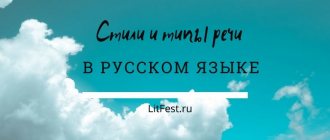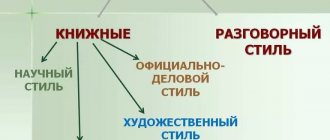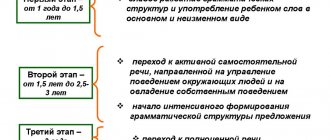4.1
Average rating: 4.1
Total ratings received: 2698.
4.1
Average rating: 4.1
Total ratings received: 2698.
Texts in Russian vary significantly in the choice of words and in their information content. How the text will look and what impression it will make depends on what style of speech we have chosen. We'll talk about speech styles.
The material was prepared jointly with a teacher of the highest category, Kuchmina Nadezhda Vladimirovna.
Experience as a teacher of Russian language and literature - 27 years.
Formal business style
Document style. It is also used in writing. Approximate and abstract reasoning is unacceptable in it. This is the most regulated style.
The writer knows where and what to write, and such a clear structure is necessary to make it easier for people working with documents to navigate the multitude of papers, and also to avoid the possibility of double understanding and interpretation. A standard form, language clichés, etc. are used.
An example of a text in a formal business style would be a statement or memo.
Substyles and genres of artistic style
| Epic (storylines are described). L.N. Tolstoy. Raid (story). |
|
|
| Lyrical (the author’s thoughts, feelings, experiences of the characters). S.A. Yesenin. Porosha (poem). |
|
|
| Dramatic (the presence of the author is not felt, much attention is paid to dialogues and interaction of characters). M. Gorky. At the bottom (drama). |
|
|
| Combined (combination of styles). A.I. Solzhenitsyn. The GULAG Archipelago (artistic journalism). |
|
|
Journalistic style
Newspaper style. He is characterized by special agitation. Its purpose is to influence the reader or listener. Expressive vocabulary and rhetorical figures (questions, exclamations, appeals, etc.) are used. Texts of public speeches, articles “on the topic of the day,” etc. are created in this style. Anyone who uses a journalistic style seeks to convince us of something, to shape public opinion. This is a rather expressive style; harsh statements, generalizations, puns, assessments, etc. are appropriate.
Functional and semantic types of speech
Speech types are often mistakenly confused with speech styles. However, a functional speech style is a set of speech elements (words and ways of constructing sentences that are special for each speech style).
And the type of speech is the way of presentation, the construction of words and sentences in a logical order. Depending on the content of the text, the following types of speech are distinguished: narration, description, reasoning.
Let's consider the features of each type of speech.
A narrative is a story about an event that occurs in a certain period of time. The actions reflected in the event are sequential and logically related to each other. The narration can come from both the third person and the first, and it is characterized by such elements as the beginning (the beginning of the event), the development of the action and the denouement (the outcome of the event being described).
Since the narrative is an event text, its speech feature is a large number of verbs and a chain development of action. The text answers the questions “what? Where? When?" - What's happened? where and with whom did it happen? when did it happen?
The narration can be pictorial (the emphasis is on changing images that “show” the event) and informative (the text not only talks about the event, but also explains it and includes interesting facts).
Example of a narrative text:
“At night a strong wind rose and it started to rain. It quietly drummed on the roof and flowed down the glass, turning the world outside the window into a blur. Streams of water washed away dust from trees and sidewalks, gurgled in gutters, and cooled the city scorching from the summer heat. And those who were not sleeping opened the windows, inhaled the damp coolness and exposed their faces to the icy drops. The city had been waiting for rain for two months, and now that it came, people smiled silently, blessing the crying sky...”
An example text - a visual narrative - answers the following questions:
- What's happened? – it started to rain in the city;
- where and with whom did it happen? – city residents waited for the rain;
- when did it happen? - It started to rain in the summer.
Description is a verbal image of an object, phenomenon, event. The description lists and reveals the main features of the selected item. The goal is to present the reader of the text with an image that is easy to imagine in color. The unity of time and place of manifestation of signs is important.
The description text consists of the following parts:
- general characteristics of the item, general impression;
- signs, details;
- overall assessment of the subject.
For example, the description can be portrait, landscape; the object of writing can be anything - a person, his emotional state, an animal, a plant, a place (city, hotel house, park, village), and the weather. Speech feature – predominance of nouns, adjectives, adverbs, minimum action and static text.
Descriptive text answers the questions “which one?” which?" (what object is being described? what does it look like? what are its qualities and properties?).
Example of descriptive text:
“It rained for the third day. Gray, small and harmful. Unpredictable, like a low gray sky. Endless. Endless. He restlessly knocked on the windows and quietly rustled on the roof. Sullen and carefree. Annoying. Bored.”
Sample text answers descriptive questions:
- what object is being described? - rain;
- what is the subject? – gray, small, harmful, unpredictable, endless, etc.
Reasoning is the development and confirmation of thought, the explanation of a phenomenon (properties of an object) and the expression of one’s own opinion. Reasoning answers the questions “why?” For what?".
The reasoning consists of the following parts:
- thesis - an idea that needs to be proven;
- justification of the thesis, supporting argumentation with examples, evidence;
- summary – results, conclusions.
The text of the argument is aimed at convincing, explaining, proving. Reasoning is characterized by the active use of rhetorical questions and introductory words - connectives: firstly... secondly... thirdly... therefore (thus accordingly); meanwhile, because, so.
The reasoning is as follows:
- reasoning-proof (why is this and not otherwise? What follows from this?);
- reasoning-explanation (what is it? where did it come from? Why is the subject exactly like that?);
- reasoning-reflection (what to do? To be or not to be? What to do?).
An example of a reasoning text:
“So, the night will pass, and the rain will stop making noise, the thunder will die down. So, what is next? Again – the sweltering heat of a stuffy summer? Again – hot asphalt? Again - a city choking in dust? Or will the weather have mercy on tired city dwellers and give at least a week of coolness? Since the weather forecasters' predictions are vague and vague, we can only wait and watch.”
An example text – reasoning-reflection – answers the following questions:
- Why? – because the rain will stop and the heat that everyone is tired of will return;
- For what? - to imagine what to expect from the capricious nature.
Types of speech are methods of presentation that solve the following author’s tasks:
- narration – dynamically reflects reality, tells about its events; narration is a clip, a movie, a change of frames;
- description – depicts a static reality, studies the object of interest from all sides; the description is a photograph, a frozen frame;
- reasoning – looks for cause-and-effect relationships between events and phenomena, expresses the author’s opinion, “because...”; This is a diagram with blocks of theses and evidence and arrows - logical questions.
Reminder: Do not confuse functional speech styles with speech types. After all, for example, a newspaper article in a journalistic style of speech can be narrative (a report from the scene), and descriptive (a note about a missing person; an advertisement for a new building), and reasoning (an analytical article).
Conversational style
Conversation style. It uses a lot of colloquial words (but not curse words, etc., since this is a style of literary language, and slang and obscene language are outside its boundaries). The topics of the conversational style are the most ordinary, the sentences are short and expressive, the vocabulary is relaxed, succinct and colorful. We find the conversational style mainly in oral speech, its favorite form is dialogue. Signs of a conversational style include the significant role of non-linguistic means of expression: facial expressions, intonation, and the like.
The style of fiction can include, depending on the author's intention, elements of any style, or several styles, or even non-literary words (for example, slang).
Expressive means
| Epithets | – the use of words, most often adjectives or adverbs, less often nouns, which affect expressiveness.
|
| Comparisons | – deepening a common feature to identify a new important property of an object.
|
| Personification | – assignment of features of animate objects to inanimate ones. Human traits are often attributed to natural phenomena.
|
| Metaphor | – a word or expression in a figurative sense (hidden comparison).
|
| Irony | creates the feeling that the character or situation is not what it seems.
|
| Hyperbola | - obvious deliberate exaggeration in order to enhance the expressiveness of thought.
|
| Litotes | – the inverse of hyperbole. Downplaying the power of the object being described.
|
| Antithesis | – a combination in one sentence (phrase) of words with the opposite meaning or emotional connotation.
|
| Inversion | - consists in changing the usual order of words in a sentence (subject + predicate, ...).
|
How to determine text style
Speech styles are studied by a special branch of linguistics - stylistics.
- To determine the style of speech in Russian, you need to pay attention to several signs: the purpose of the statement;
- vocabulary;
- form and genre;
- is it oral or written;
- who is the recipient of the text?
In addition, each style has some characteristics.
The table below shows speech styles and their features.
| Speech style | target | peculiarities | where is it used |
| Official business | Convey official, business information | Significant unification; special words - clerical words | document |
| Scientific | Provide scientific information | Exact numbers, a lot of information, terms | encyclopedia, textbook |
| Colloquial | Communication, transfer of ordinary information | Colloquial vocabulary, short sentences, simple syntax | oral speech |
| Journalistic | Convince the reader of something | Rhetorical figures, expressive vocabulary | newspaper, oral presentation |
| Art | Excite feelings and imagination with artistic images | Expressive means of language | literary work |
Test on the topic
- /10
Question 1 of 10How many functional styles are usually distinguished in the Russian language?
Start test
Hall of Fame
To get here, take the test.
- Marufjon Ganiev
10/10
- Nikita Gavrilin
8/10
- Sergey Pisarenko
7/10
- Andrey Romanov
7/10
Typical differences
Each author has his own attitude to the topic of the article. When formulating it, they use speech that matches the type:
- description;
- narration;
- reasoning.
Description
Description is a speech where an object, event or phenomenon is verbally depicted. It contains enumerations, designations of the characteristics of an object, words that denote its properties and qualities. Among them are nouns, adverbs, adjectives. Verbs are predominantly in the past tense. They are usually of an imperfect appearance.
Description allows you to imagine an object, person, place. The author points out his general condition (what he is like), individual signs (what it is like here or for him), expresses his attitude towards him, and draws a conclusion.
Narration
A narrative is the news of an ongoing incident at a specific point in time. The incidents discussed in it are sequential and logical, changing with each other. It can be presented in the first or third person. It is characterized by a plot (the beginning of the story), development of content, climax, and denouement (ending). Narrative speech contains many verbs and a chain of actions. From it you can find out what happened and where, when, with whom. That is, imagine actions, movements of people, phenomena.
Reasoning
Reasoning is speech that addresses a specific problem. The author provides arguments, evidence of thoughts, explanations of the characteristics of objects and phenomena. He expresses his opinion, assessment, feelings. In such a text there are many introductory words (therefore, so, thus), subordinating conjunctions (so that, since, although).
Contents of science
Functional stylistics is revealed in a number of concepts:
- Functional style. This is a system of characteristic features that distinguish each type of speech.
- Factors that form style. They are associated with the sphere of communication outside of linguistics and linguistic type.
- Style trait. This is a quality, a characteristic feature that distinguishes each speech variety.
- Language features. These are phraseological units and lexical units, morphemes, word-formation, syntactic units that embody the main idea and features.
- Stylistic analysis. This is the pinnacle of linguistic research, which relies on identifying the functions of all units at different levels.
These are the basic concepts in which functional stylistics is revealed. They are considered in school practice.
Lecture 4. Functional styles of modern Russian literary language. Scientific style
1. System of functional styles of the modern Russian language.
2. The concept of stylistic norms.
3. Scientific functional style, its linguistic features.
4. Speech norms for educational and scientific fields of activity.
Functional styles are special varieties of a single literary language that are used in a particular area, perform certain tasks (functions) and have certain features in the selection and use of linguistic means. In the modern Russian literary language, four functional styles are distinguished: colloquial, journalistic, official business, scientific.
The conversational style is used in the sphere of everyday communication and is implemented mainly orally. This style is contrasted with other styles that are associated with various spheres of social activity and are implemented mainly in written form. The main function of the conversational style is the function of communication. Conversational style has such stylistic features as ease and emotionality. A distinctive feature of this style is the use of linguistic means with a colloquial overtones: special vocabulary and phraseology, as well as incomplete sentences.
The journalistic style is implemented in the socio-political sphere. Its main function is the function of social influence. Initially, it acted as a book style and was used in newspapers and magazines, i.e. journalism (hence its name), however, today the oral variety of journalistic style is also actively developing, incorporating many features of colloquial speech. Style features – passion, appeal. In the journalistic style, socio-political vocabulary and phraseology, incentive and exclamatory sentences, rhetorical questions and appeals are actively used. Genres of journalistic speech: article, essay, interview, information, report, commentary, propaganda speech, etc.
The official business style is used in the field of administrative and legal activities. The most important role in official business speech is played by the function of communication and social regulation (information-directive function). Style features – impersonality, standardization. Typical language means: neutral words, official business terminology, standard expressions and phrases. The genres of business speech are extremely diverse. Among them are an autobiography, a statement, a report, a protocol, an order, an explanatory note, a law, a charter, a contract, etc.
The scientific style is used in the field of science and technology. The main task of the scientific style is the message and logical proof of the truth of what is being communicated (information-argumentative function). The scientific style has three substyles: proper scientific, scientific-educational and popular science. In the scientific style, neutral words and words with a generalized and abstract meaning (reliability, research, analysis, etc.) predominate; special terminology and general scientific vocabulary (function, element, system, etc.) are actively used.
In morphology, the noun predominates over the verb, impersonal forms over personal ones, the so-called “present timeless” (the Volga flows into the Caspian Sea) becomes widespread. The scientific style is dominated by a logically defined, bookish syntax. Among the genres of scientific speech, one should name an article, a monograph, a review, a review, a summary, an abstract, an annotation, a textbook, a teaching aid, etc. Annotations and abstracts are important in the system of these genres, the content and structure of which most clearly and visually reflects orientation of scientific speech towards the compressed transmission of objective information.
Each functional style involves the targeted use of linguistic phenomena, taking into account their meaning and expressiveness. The development of a particular style is associated with the choice of expressions, linguistic forms, constructions that are most suitable for the purposes of communication in a certain social environment, for the most effective expression of certain thoughts. Thus, the identification of specific functional styles takes into account the uniqueness of various spheres of application of linguistic phenomena and the specificity of expressiveness characteristic of a certain style.
It must be borne in mind that functional styles , representing the largest speech varieties, record the most profound stylistic features. Each of them is also subject to further intra-style differentiation . This differentiation can be roughly compared to a nesting doll: the main functional styles are divided into a number of varieties, each of which includes even more specific varieties, etc. For example, the scientific style, while retaining its main stylistic features, is divided into proper scientific and scientific-technical. In turn, both of them can have popular scientific versions of presentation.
In addition, each of the stylistic varieties of the scientific and scientific-technical style can be differentiated in relation to specific types of science (biology, geology, history, ethnography, etc.). In this case, differences arise, both of a lexical nature and manifested in a number of linguistic features. Such stylistic varieties have an even more subtle differentiation: they take into account the genre and method of presentation. Depending on the genre, the scientific style can be implemented in dissertations, monographs, abstracts, articles, reports, scientific information, etc. This style acquires additional variability in connection with the method of presentation: description, narration, reasoning. Moreover, certain stylistic varieties differ from each other and, depending on the author’s individuality, bear its features.
As we can see, style differentiation is associated with the action of a large number of non-linguistic factors. Without taking them into account, it is almost impossible to implement it. These factors influencing the identification of particular stylistic features are unequal in their role in the process of style formation. In addition, not all factors affecting speech can be classified as style-forming. Many linguists believe that the development of style is based on the principle of choosing the necessary linguistic means, but some, say, individual factors (gender, age, etc.) exclude the author of a particular statement from the possibility of such a choice
Each functional style has its own norms . These norms are called stylistic; violation of them is the cause of stylistic errors. (For example: “Girl, what issue are you crying about?”)
Functional styles have their own characteristics of using a general literary norm; it can exist both in written and oral form. Each style includes works of different genres that have their own characteristics.
Most often, styles are compared on the basis of their inherent word usage, since it is in word usage that the difference between them is most clearly manifested. However, grammatical characteristics are also important here; for example, the style of many texts in the tabloid press should be defined as journalistic largely on the basis of the syntactic structure; in the area of word usage, we can see both colloquial and generally extraliterary (colloquial, slang) units. Therefore, when creating a work belonging to a certain style, one should comply not only with the lexical norms of the style, but also with morphological and syntactic norms.
Conversational style is associated with the sphere of direct everyday communication. This area is characterized by a predominantly oral form of expression (except for private correspondence of an everyday nature), which means that intonation and facial expressions play a large role. In everyday communication, there are no official relations between speakers; contact between them is direct, and speech is unprepared. In the conversational style, as in all others, neutral words are widely used (lie, blue, house, earth, left), but bookish words are not used. It is normative to use words with a conversational stylistic connotation (joking, chattering, locker room, hype, completely, leisure, sort of). It is possible to use emotionally evaluative words: affectionate, familiar, reduced (cat, boast, headless, fit in), as well as words with specific evaluative suffixes (granny, daddy, sunshine, home). In a conversational style, phraseological units are actively used (hit the pocket, play the fool, two inches from the pot). Words formed by condensing a phrase into one word or a long compound word into a shortened word (unud, cash, communal, ambulance, condensed milk, electric train) are often used.
The morphological norm of conversational style , on the one hand, generally corresponds to the general literary norm, on the other hand, has its own characteristics. For example, in the oral form the nominative case predominates - even where in the written form it is impossible (Pushkinskaya, come out7 Child, look), truncated forms of function words are often used (at least, so that, or whatever). The norm of verb use allows the formation of forms that do not exist in normative book speech with the meaning of repetition (sat, used to say) or, conversely, one-time (pushed, fucked). In a conversational style, the use of participles and gerunds, which are considered a sign of bookish speech, is inappropriate. More often, the prepositional case is formed with the ending -у (on vacation), the plural with the ending -a (reprimand). For the syntax of conversational style, the norm is the use of sentences in which some component is missing, but is easily restored (He back to me - incomplete). Such sentences are called elliptic . Simple sentences predominate, words-sentences are often used (Clear. No. Possible. Why?), as well as interjections and interjection phrases (Here you go! Mommies! Oh! Oh, you!).
The official business style serves the sphere of purely official relations. This is the style of administrative and clerical documentation, legislative acts, and diplomatic documents. It is characterized by extreme concreteness of content with abstract, typified, cliched means of expression. Official speech is characterized by specificity, standard presentation and the nature of a prescription, an obligation. This determines the language norm of style. Against the background of neutral and common words (employee, commission, control and marriage, dominate), words and phrases are used that can be attributed to professional (legal, accounting, diplomatic, etc.) terminology, such as plaintiff, impute, contractor, taxpayer, declaration, notice, memorandum, tariff schedule, rent, federal bodies, budgetary institutions, as well as office stamps, the use of which in an official business style is not a disadvantage, much less a mistake, but a special stylistic norm: proper, the above , for the purpose of improvement, come into force, for the past period, bring to attention. An extremely dry and neutral style of presentation should be free not only from colloquial and especially slang or dialect layers, but also from literary words that have an emotionally expressive connotation. In the official business style, complex abbreviated words (CIS, GKO, Ministry of Agriculture and Food, AIC, St. Petersburg State University, JSC, IMF) and nouns formed from verbs (documentation, storage, non-compliance) are often used, since this style is characterized by a clear predominance of the name over the verb.
The official business style is characterized by the frequent use of verbs in the form of the imperative mood and in an indefinite form in the sense of the imperative mood (exempt from rent, establish a monthly surcharge). If verbs are used in the present tense, they also have the nature of a prescription iwkoh establishes, the benefit does not apply). The norm is the use of the so-called logical, bookish syntax: the use of narrative, two-part, complete sentences with direct word order; sentences complicated by homogeneous members, participial and participial phrases; complex sentences.
The journalistic style is focused , on the one hand, on communicating information, and on the other, on influencing the reader or listener. Therefore, it is characterized by a combination of expressiveness (for maximum impact) and standard (for speed and accuracy of information transfer). This is the style of newspaper and magazine articles, interviews, reports, as well as political speeches, radio and television programs.
In addition to neutral ones, in the journalistic style, evaluative and emotional words are often used (ambition, totalitarian, foppishness, philistinism, thug), words with a figurative meaning (dirt in the meaning of “immorality”, penny in the meaning of “petty”, accentuate in the meaning of “bring to the fore” "). “Political” vocabulary can be considered typical for journalism: president, parliament, faction, dissident, deputy, patriot, society, speaker, constitution. High book vocabulary is also used in a journalistic style: to dare, to erect, to commemorate. This style is characterized by the use of metaphor as a way of assessing the surrounding reality, for example, “military” metaphors (mobilize, landing), “construction” metaphors (“building of outdated politics,” “cultural basements,” “national apartments”), “road” metaphors ( political impassability", "reform ship", "federation train"). In this style, colloquial words and phraseological units are also used (to paint, to get, to be strong in hindsight, to hang noodles on one’s ears, to be honest).
Morphological norms of journalistic style largely determine the possibility of combining book and colloquial style. Adjectives and adverbs with evaluative meanings are often used: serious, minor, significant, contemptuous, magnificent). The pronounced personality of the style determines the frequency of personal pronouns. The present tense of the verb is often used (the so-called “present of reporting”): “Halfway up, I decide to go up another way,” “We begin to explore the surroundings.” Along with the present, the past tense is often used: “Everyone has always written only about love and war,” “ Proposals came in of a very different nature.”
Syntactic norms of journalism are associated with the need to combine expressiveness and information richness: exclamatory sentences, interrogative sentences (including rhetorical questions), repetitions, changing the order of words in a sentence to highlight a word are used (This is a short-sighted policy).
, borrowed words associated with new economic, political, everyday, scientific and technical phenomena are extremely common The terms of various fields of knowledge are rethought, most often economic, political, “computer”: wild market, consensus , stagnation, data bank. Colloquial and slang vocabulary is intensively used, which becomes a special means of expression: scoop, party, showdown, chernukha, fan, chaos. Religious vocabulary also becomes an expressive means of journalism: faith, Orthodoxy, righteous. Book words are used that were previously rarely used; It is through journalism that half-forgotten words, such as mercy and charity, return to us. However, the journalistic style still remains mainly a bookish style, as evidenced not only by word usage, but also by the syntactic structure - the syntax of journalism is bookish-oriented.
Scientific style is used in the fields of science and technology . The scientific style is used in the field of science and technology. The main task of the scientific style is communication and logical proof of the truth of what is being communicated (information-reasoned function). Within the framework of the scientific style of speech, the following substyles have formed:
1) actually scientific (academic);
2) scientific and educational;
3) scientific and technical;
4) popular science
The academic substyle is the core of the scientific functional style. It is characterized by such features as accuracy, responsibility, generalization, and logic. Scientific monographs, articles, dissertations are written in the academic style, and discussions are held between specialists.
The scientific and technical substyle is used in the production sector. It is less characterized by abstraction, due to the need for a specific description of production processes. In this regard, the scientific and production substyle is closer to the language of documents and the official business style.
In scientific, educational and popular science substyles, the use of expressively colored and figurative language means is allowed. The scientific-educational substyle, at the same time, is distinguished by a more systematic presentation, which is associated with its main task - to teach the basics of a certain discipline.
The task of the popular science style is to interest the mass reader and encourage him to improve his cultural level. Among the genres of scientific style are articles, monographs, reviews, reviews, summaries, abstracts, annotations, textbooks, teaching aids, guidelines, etc.
In the scientific style, neutral words and words with an abstract and generalized meaning predominate. Almost every word appears in a scientific text as a designation of an abstract concept or an abstract object - “speed”, “time”, “limit”, “quantity”, “regularity”, “development”. Often such words are used in the plural, which is not typical for other styles: “magnitude”, “particular”, “strength”, “length”, “latitude”, “emptiness”, “speed”. In the scientific style, special terminology and general scientific vocabulary (function, element, system, etc.) are actively used. The scientific style is distinguished by its specificity in the use of grammatical categories and forms. The noun here prevails over the verb, impersonal forms over the personal, the so-called “present timeless” becomes widespread (for example: “Carbon constitutes the most important part of the plant”, “The sum of the squares of the legs is equal to the square of the hypotenuse.”). The 1st and 2nd person singular forms of verbs and personal pronouns are not common in scientific style. Adjectives in scientific speech are not used as often as in other styles. As a rule, they are part of terms and have a precise and highly specialized meaning (hence the predominance of relative adjectives over qualitative adjectives in scientific speech).
Scientific speech is distinguished by emphasized logic and bookishness. Logic must be present at all language levels: in a phrase, a sentence, between two adjacent sentences, in a paragraph and between paragraphs, in the whole text.
Logic is ensured by using the following means:
1) connecting sentences using repeated nouns, often in combination with demonstrative pronouns (that, that, etc.);
2) the use of adverbs indicating the sequence of thought (first, first of all, next, then);
3) the use of introductory words expressing the relationship between the parts of the statement (therefore, secondly, finally, so, thus);
4) use of conjunctions (since, because, in order);
5) the use of constructions and expressions of communication (now let’s focus on the properties...; let’s move on to consider the issue...; further note... etc.)
The requirements for strict logic in a scientific text determine the predominance in it of complex sentences with a conjunction, especially complex sentences.
An abstract, being a summary of some information , can be self-sufficient in certain situations and in business communication, since - unlike an abstract, theses and synopsis - it is a complete text. However, annotation and summarizing, due to their importance in such relevant areas for modern youth as scientific and business, and the certain difficulty of mastering the skills of writing them, require more attention. Therefore, teaching these types of written speech is considered separately as, although an additional, but very important aspect of speech communications.
The word annotation comes from the Latin annotatio - remark, note. An abstract is currently called a brief description of a book (or article) containing a list of the main sections, topics or issues discussed in the work. The abstract of the book may also include an indication of the features in the presentation of the material and the addressee (for whom it is intended). Speaking schematically, an abstract for a book (primarily scientific or educational) answers the questions about what/from what parts? How? for whom? These are, as it were, its basic, standard semantic elements. Each of them has its own linguistic means of expression, which are indicated below.
The abstract of a book is placed on the reverse side of its title page and serves (along with its title and table of contents) as a source of information about the contents of the work. After reading the annotation, the reader decides how much he might need the book. In addition, the ability to annotate read literature helps to master summarizing skills.
The word abstract comes from the Latin referre , which means “to report, report.” Currently, an abstract is primarily a short, most often written, presentation of a scientific work - an article or a book (or several scientific works). The presentation of one work usually contains an indication of the topic and composition of the work being reviewed, a list of its main provisions with arguments, and less often - a description of the methodology and conduct of the experiment, the results and conclusions of the study. We will call such an abstract simple, informational. In Russia, special abstract journals are published that contain abstracts of this kind and thereby introduce the latest Russian and foreign literature in various fields of scientific knowledge: physics, philosophy, etc.
usually write abstracts To write such thematic abstracts, it may be necessary to involve more than one source, at least two scientific works. In this case, the abstract is not only informational, but also a review.
A simple informational abstract may contain an assessment of certain provisions, called by the author of the work being reviewed. This assessment most often expresses agreement or disagreement with the author's point of view.
The abstract may contain quotations from the work being reviewed. They are always placed in quotation marks. Three types of citation should be distinguished, with punctuation marks placed as in sentences with direct speech.
1. The quotation comes after the words of the abstract writer. In this case, a colon is placed after the words of the abstract writer, and the quotation begins with a capital letter. For example: The author of the article states: “In our country there has really been a rapid growth of national self-awareness.”
2. The quotation comes before the words of the abstract writer. In this case, a comma and a dash are placed after the quotation, and the words of the abstract writer are written with a small letter. For example: “In our country there is truly a rapid growth of national self-awareness,” says the author of the article.
3. The words of the abstract writer appear in the middle of the quotation. In this case, a semicolon is placed before and after them. For example: “In our country,” says the author of the article, “there is truly a rapid growth of national self-awareness.”
4. The quotation is directly included in the words of the abstract writer. In this case (and it is the most common in an abstract), the quotation begins with a small letter. For example: The author of the article claims that “in our country there is truly a rapid growth of national self-awareness.”










